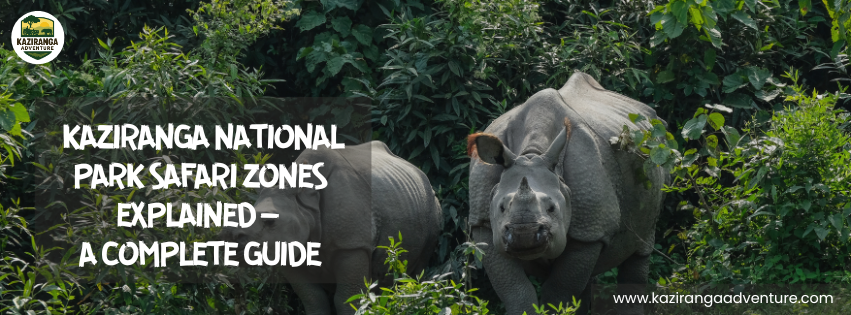Kaziranga National Park, located in Assam, is one of India’s most celebrated wildlife sanctuaries and a UNESCO World Heritage Site. Known as the home of the Great Indian One-Horned Rhinoceros, Kaziranga also shelters tigers, wild elephants, swamp deer, water buffaloes, and over 500 species of birds. To make safari experiences more organized and enjoyable, the park is divided into four major safari zones, each with its own unique terrain, wildlife, and adventure opportunities.
Understanding these safari zones is essential for travelers who want to make the most of their Kaziranga visit. Each range offers a different perspective of the park’s ecosystem—ranging from floodplains and grasslands to wetlands and thick forests. Let’s explore each zone in detail:
1. Kohora (Central Range)
The Central Range is the most visited safari zone in Kaziranga, as it is centrally located and provides a balanced wildlife experience.
Highlights: High probability of spotting one-horned rhinos, wild elephants, swamp deer, hog deer, and wild boars.
Landscape: A beautiful mix of grasslands, water bodies, and semi-dense forests.
Best for: First-time visitors, families, and travelers who want a complete experience.
Safari Options: Jeep Safari and Elephant Safari.
The Kohora range is often considered the heart of Kaziranga and is perfect for those who want a glimpse of everything—wildlife, birds, and stunning landscapes.
2. Bagori (Western Range)
The Western Range, also known as the Bagori Range, is extremely popular among wildlife photographers and seasoned travelers.
Highlights: Known for close rhino sightings, wild buffaloes, swamp deer, elephants, and sometimes tigers.
Landscape: Wide grasslands with scenic wetlands, making it easier to spot large mammals.
Best for: Wildlife photographers and those looking for iconic rhino captures.
Safari Options: Jeep Safari and Elephant Safari.
The Bagori range is regarded as the best zone for rhino sightings, as animals are often seen grazing in open areas.
3. Agoratoli (Eastern Range)
If you’re a birdwatching enthusiast, the Eastern Range (Agoratoli) is the zone you shouldn’t miss. Situated near the Brahmaputra River, this area is a paradise for migratory and resident birds.
Highlights: Spot migratory waterfowl, pelicans, storks, eagles, and endangered bird species. Mammals like wild boars, elephants, and rhinos can also be seen.
Landscape: Riverbanks, wetlands, and swampy areas rich in birdlife.
Best for: Birdwatchers, nature lovers, and travelers seeking a peaceful safari experience.
Safari Options: Jeep Safari only (no elephant safaris here).
The Agoratoli zone offers an entirely different vibe compared to the central and western ranges, making it perfect for those who want a serene, bird-focused experience.
4. Burapahar (Ghorakati Range)
The Burapahar or Ghorakati Range is the least crowded safari zone in Kaziranga, making it perfect for travelers who prefer peace and offbeat experiences.
Highlights: Dense forests with sightings of hoolock gibbons, langurs, elephants, rhinos, and a variety of bird species.
Landscape: Thick woodlands and hilly terrain, unlike the grassland-dominated central and western ranges.
Best for: Adventure seekers, trekkers, and those who want a quieter experience.
Safari Options: Jeep Safari, nature walks, and trekking trails.
Burapahar provides a more intimate experience with nature, ideal for eco-tourism lovers and explorers.
Safari Experience & Tips:-
Best Time for Safari: November to April (winter and spring offer clear views and rich wildlife sightings).
Booking: Jeep safaris can be pre-booked, while elephant safaris have limited availability and should be reserved in advance.
Duration: Safaris usually last 2–3 hours in the morning or afternoon.
Entry Points: Each zone has its own entry gate, so plan your accommodation nearby for convenience.
Which Zone Should You Choose?
For First-Time Visitors: Kohora (Central Range)
For Best Rhino Sightings: Bagori (Western Range)
For Birdwatching: Agoratoli (Eastern Range)
For Offbeat Adventure: Burapahar (Ghorakati Range)
Conclusion
Kaziranga National Park’s safari zones each offer something unique—from the thrilling rhino encounters of Bagori to the tranquil birdwatching opportunities in Agoratoli. By understanding the characteristics of each zone, travelers can select the safari that best matches their interests and create unforgettable memories in Assam’s most iconic national park.
